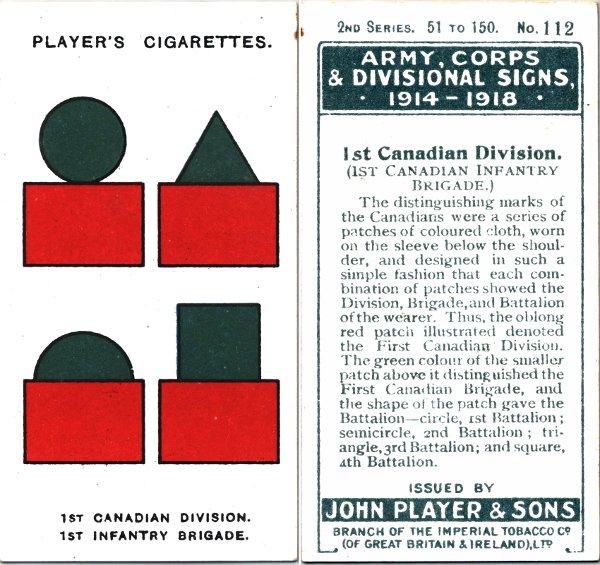Topic: CEF

The above image shows the Player's cigarette card featuring the shoulder flashes of the 1st Canadian Infantry Brigade worn during the First World War.
Cigarette cards have a long history of being used by tobacco companies as an incentive to buy their wares. Their imagery featuring many aspects of life at home and abroad, the cigarette companies readily drew on military themes both in peace and war for their series of cards. One such series, issued by the John Player & Sons, displayed the unit shoulder flashes of the infantry brigades of the Canadian Expeditionary Force of the First World War.
The shoulder flashes used to distinguish the infantry divisions, brigades and battalions on the battlefield, and in camps behind the lines, was based on a simple system of colours and shapes. The rectangular divisional patches identified the wearer's division by their colour, the evolution of colour choices is described in the excellent reference work "Distinguishing Patches", by Clive Law, once the system was finalized, the following colours were used:
- 1st Canadian Infantry Division - RED
- 2nd Canadian Infantry Division - BLUE
- 3rd Canadian Infantry Division - FRENCH GREY
- 4th Canadian Infantry Division - GREEN
Each rectangular divisional patch was surmounted by a geometrically shaped device to show the wearer's brigade and battalion. The colours for these devices were:
- First brigade in the division - GREEN
- Second brigade in the division - RED
- Third brigade in the division - BLUE
Lastly, the shape of the device indicated which battalion within the brigade the soldier served with:
- First battalion in the brigade – ● CIRCLE (1 1/2 inches in diameter)
- Second battalion in the brigade – ◒ HALF-CIRCLE (2 inches in diameter)
- Third battalion in the brigade – ▲ TRIANGLE (2 inches on each side)
- Fourth battalion in the brigade – ■ SQUARE ( 1 1/2 inches on each side)
This straightforward system worked well for the infantry units, but the many other units within each division departed from this and a more complex mixture of patches appeared although consistency of patterns remained between the divisions. For those who wish to delve deeper into the CEF system of shoulder flashes, and those of other periods of service in the Canadian Army, I highly recommend "Distinguishing Patches."

